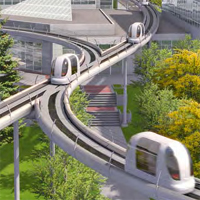Urban Quality vs single travel: the Personal Rapid Transit
Abstract
The great increase in the demand for private mobility with the consequent macroscopic growth of channels to meet it, together with short-sighted policies of transport and urban development spread above all in Italy, has produced pollution, congestion and unlivability in the last fifty years.
The hope of assuring the maximum individual freedom of travel to people living in consolidated urban centres, in addition to those living in the outskirts arisen and developed without any reasonable urban logic, still goes on producing congestion of vehicular traffic, considered, by the majority of citizens, the main cause of the deterioration of the quality of life in our cities.
Indeed, also the most recent reports on environment in Italian cities show that the pollution levels are increasing in the big cities, although the news are full of very expensive projects, innovative solutions and unexpected goals continuously shown by public administrations. One of the main environmental detractors is car traffic, which has recently gained on public transport. unlike the previous period. Most of mobility policies implemented in our cities aims at reaching the modal balance by means of measures for controlling and managing the demand for mobility, for mitigating traffic and limiting circulation., such as the road pricing and the parking strategies; for developing and increasing public transport and not polluting means of transport, car sharing and car pooling.
All of them have showed modest results both in terms of pollution reduction and vehicular traffic reduction. For over fifty years, mostly in the United States, the Personal Rapid Transit has been tested, a system of public transport trying to join two apparently incompatible factors: the possibility of assuring individual travels and the need for decreasing the levels of acoustic and air pollution as well as the congestion caused by private vehicular traffic. In Italy this system is still not well known despite the versatility of its fields of application. In the United States and all over the world the most successful applications concern circumscribed mono-functional urban ambits, such as large areas for offices, airports and so on, but the characteristics of this system - such as flexibility, capability of integration with other wide-range systems of public transport, little dimensions of the exchange junctions, quite low cost - can allow to realize it also in different typologies of area.If many people are doubtful about the effectiveness of this system, on the contrary, other people think that its steady implementation and experimentation is necessary to improve urban liveability.These last ones believe, in fact, that the combination of small vehicles similar to private car, the advantage of trips without intermediate stops and changes of car, cost reduction, possibility of a wider accessibility not reachable by traditional means of public transport are the key basic elements to replace car travels with low polluting means of public transport.Downloads
References
Bettini V. (2004), Ecologia urbana, Utet Libreria, Torino.
Isfort-ASSTRA (2010), Nessun dorma. Un fututro da costruire, 7°Rapporto sulla mobilità urbana in Italia, Roma.
Gasparini L. (2005), Descrizione e potenzialità dei Sistemi di Trasporto tipo AGT/PRT-HCPRT,www.jpods.com.
ISSI - Istituto Sviluppo Sostenibile Italia, Manifesto sulla mobilità urbana sostenibile “In Città liberi dall’auto” www.issi.it.
Kornhauser A.L. (2005), Personal Rapid Transit (PRT) for New Jersey, Orf 467 Transportation Systems Analysis, Princeton University.
Tegnér G. (1998), Personal Rapid Transit in Stockholm-Market Demand and Economic Appraisal, TRANSEK Consultants Company, Solna, Sweden.
UE (2009), Piano d’azione sulla mobilità urbana Che cosa può fare l’Unione Europea?, MEMO/09/424, Bruxelles, 30 settembre 2009.

Copyright (c) 2014 Tema. Journal of Land Use, Mobility and Environment

This work is licensed under a Creative Commons Attribution 4.0 International License.
Authors who publish in this journal agree to the following:
1. Authors retain the rights to their work and give in to the journal the right of first publication of the work simultaneously licensed under a Creative Commons License - Attribution that allows others to share the work indicating the authorship and the initial publication in this journal.
2. Authors can adhere to other agreements of non-exclusive license for the distribution of the published version of the work (ex. To deposit it in an institutional repository or to publish it in a monography), provided to indicate that the document was first published in this journal.
3. Authors can distribute their work online (ex. In institutional repositories or in their website) prior to and during the submission process, as it can lead to productive exchanges and it can increase the quotations of the published work (See The Effect of Open Access)
